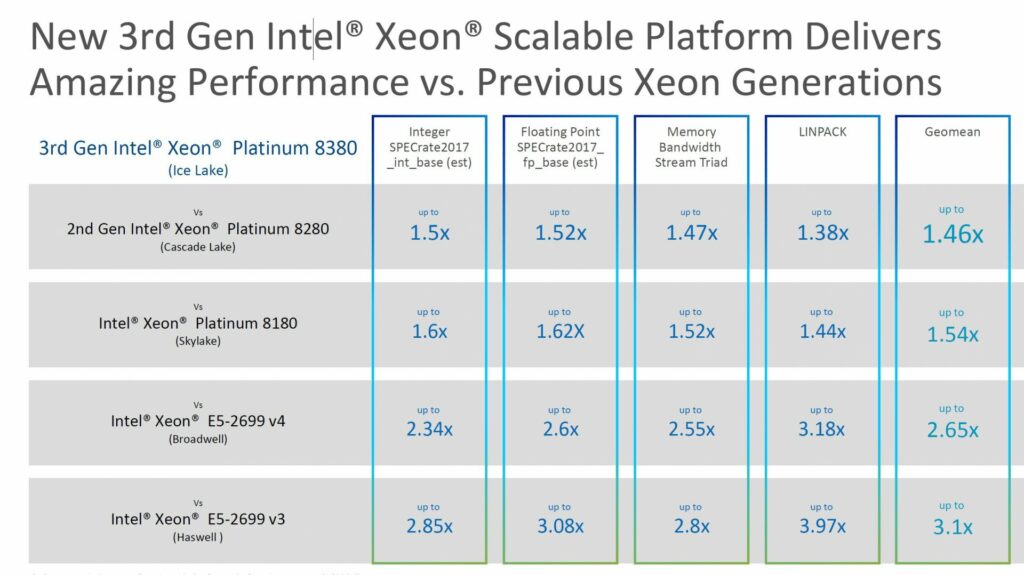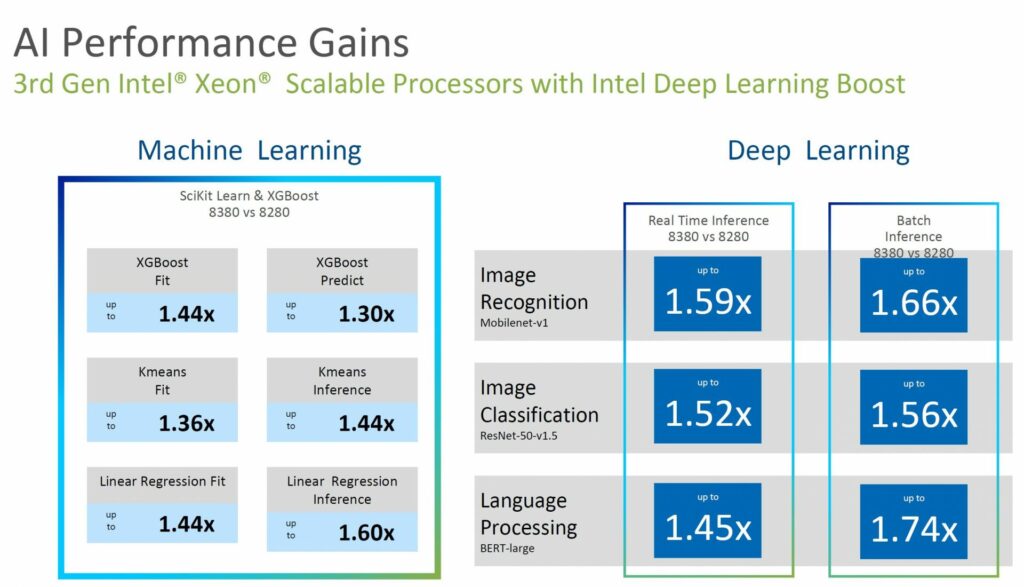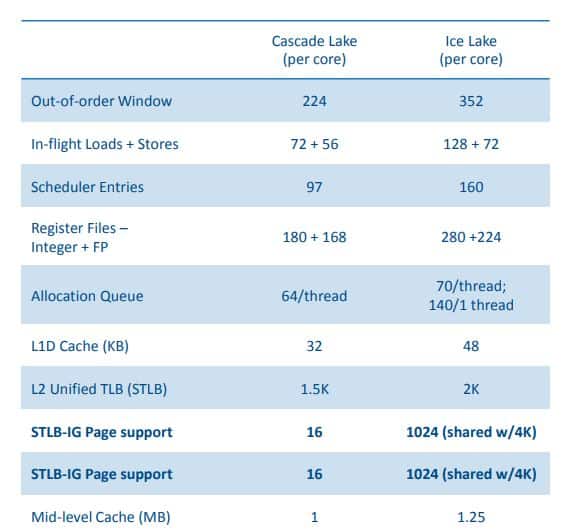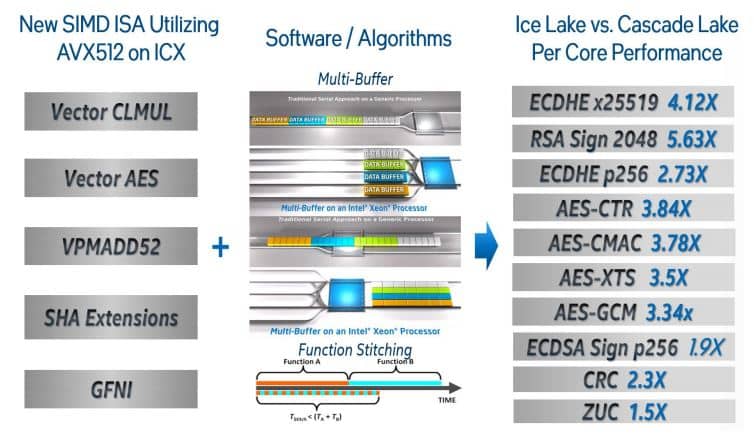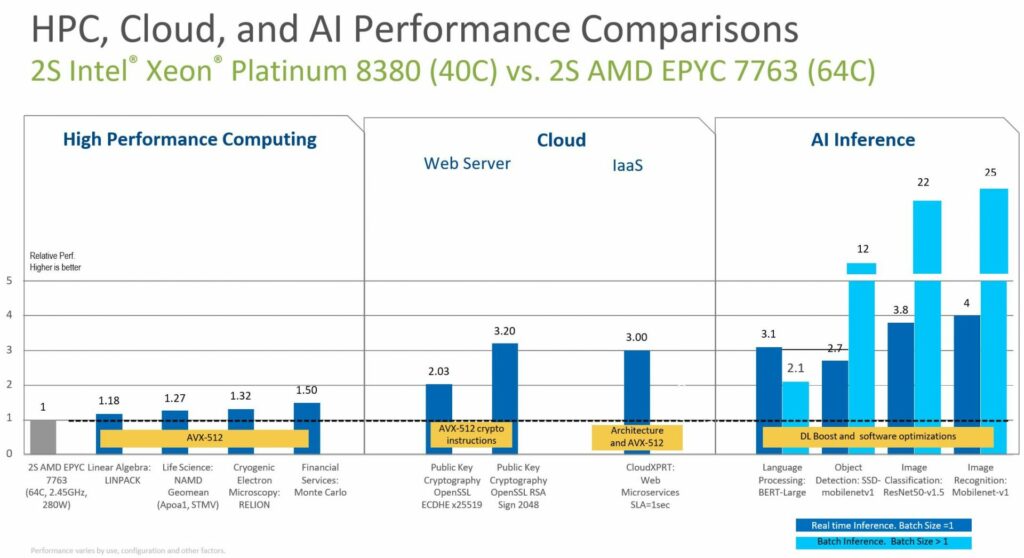Intel has been looking to bring the 10nm architecture to the table for a while now, and that day has finally arrived with the launch of the company’s new 3rd Gen Xeon Scalable CPUs, code-named Ice Lake. Looking at raw numbers, Intel is the world’s most broadly deployed data center processor (over 1 billion deployed in the Cloud since 2013 and over 50 million processors physically shipped). That being the case, there are several customers looking for an upgrade and the new benefits that these processors can bring, especially for in the ecosystem hardware like Optane SSDs, PMem, and Intel FPGAs that leverage PCIe Gen4.
Intel has been looking to bring the 10nm architecture to the table for a while now, and that day has finally arrived with the launch of the company’s new 3rd Gen Xeon Scalable CPUs, code-named Ice Lake. Looking at raw numbers, Intel is the world’s most broadly deployed data center processor (over 1 billion deployed in the Cloud since 2013 and over 50 million processors physically shipped). That being the case, there are several customers looking for an upgrade and the new benefits that these processors can bring, especially for in the ecosystem hardware like Optane SSDs, PMem, and Intel FPGAs that leverage PCIe Gen4.
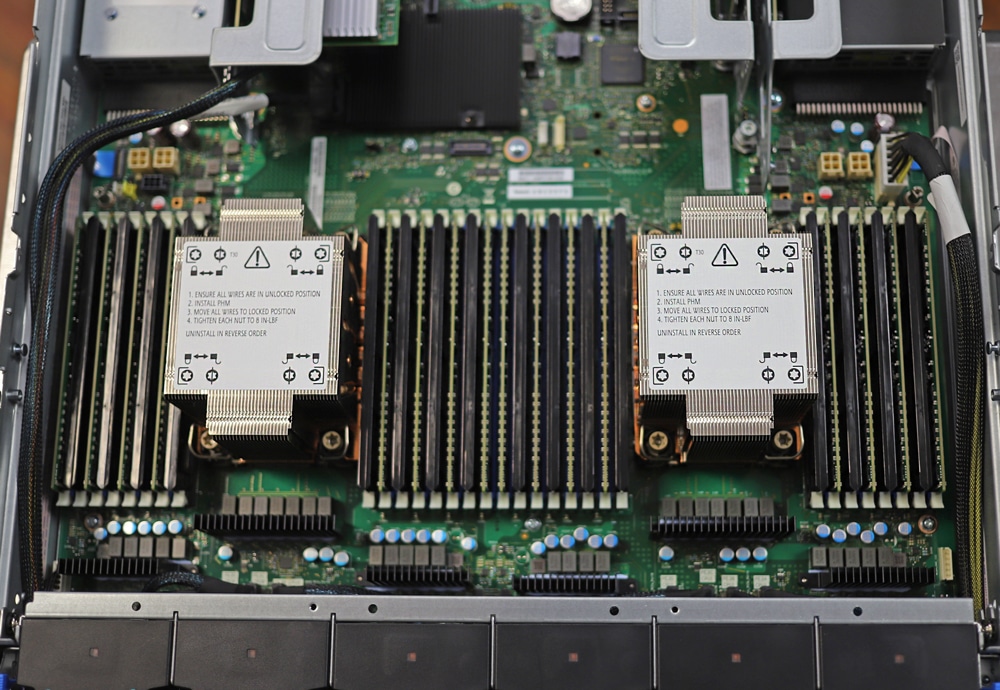
The new Intel 3rd Gen Xeon Scalable processors are the company’s most powerful and advanced data center platform to date. This is achieved by a significant increase in core performance, memory, and I/O bandwidth. More specifically, the platform supports up to 6TB of system memory, up to 8 channels of DDR4-3200 memory, and up to 64 lanes of PCIe Gen4 per socket.
The new Ice Lake processors are available in models from 8 to 40 cores with a wide range of frequency, feature, and power levels. They also now feature built-in workload acceleration with Intel Deep Learning Boost, Intel Advanced Vector Extensions 512, and Intel Speed Select Technology. These factors allow it to accelerate diverse workloads, including cloud, network, and intelligent edge use cases.
Intel 3rd Gen Xeon Scalable Models, Specifications, and Pricing
| SKU | Cores | Base (GHz) | Single Core Turbo (GHz) | All Core Turbo (GHz) | Cache (MB) | TDP (Watts) | Support for Intel Optane Persistent Memory 200 Series |
Intel SGX Enclave Capacity (Per Processor) | Recommended Customer Pricing (RCP) in $ US Dollars |
| Optimized for highest per-core scalable performance | |||||||||
| 8380 | 40 | 2.3 | 3.4 | 3.0 | 60 | 270 | Yes | 512 GB | $8099 |
| 8368 | 38 | 2.4 | 3.4 | 3.2 | 57 | 270 | Yes | 512 GB | $6302 |
| 8362 | 32 | 2.8 | 3.6 | 3.5 | 48 | 265 | Yes | 64 GB | $5448 |
| 8360Y | 36 | 2.4 | 3.5 | 3.1 | 54 | 250 | Yes | 64 GB | $4702 |
| 8358 | 32 | 2.6 | 3.4 | 3.3 | 48 | 250 | Yes | 64 GB | $3950 |
| 6354 | 18 | 3.0 | 3.6 | 3.6 | 39 | 205 | Yes | 64 GB | $2445 |
| 6348 | 28 | 2.6 | 3.5 | 3.4 | 42 | 235 | Yes | 64 GB | $3072 |
| 6346 | 16 | 3.1 | 3.6 | 3.6 | 36 | 205 | Yes | 64 GB | $2300 |
| 6342 | 24 | 2.8 | 3.5 | 3.3 | 36 | 230 | Yes | 64 GB | $2529 |
| 6334 | 8 | 3.6 | 3.7 | 3.6 | 18 | 165 | Yes | 64 GB | $2214 |
| 6326 | 16 | 2.9 | 3.5 | 3.3 | 24 | 185 | Yes | 64 GB | $1300 |
| 5317 | 12 | 3.0 | 3.6 | 3.4 | 18 | 150 | Yes | 64 GB | $950 |
| 5315Y | 8 | 3.2 | 3.6 | 3.5 | 12 | 140 | Yes | 64 GB | $895 |
| Scalable performance | |||||||||
| 8352Y | 32 | 2.2 | 3.4 | 2.8 | 48 | 205 | Yes | 64 GB | $3450 |
| 6338 | 32 | 2.0 | 3.2 | 2.6 | 48 | 205 | Yes | 64 GB | $2612 |
| 6336Y | 24 | 2.4 | 3.6 | 3.0 | 36 | 185 | Yes | 64 GB | $1977 |
| 6330 | 28 | 2.0 | 3.1 | 2.6 | 42 | 205 | Yes | 64 GB | $1894 |
| 5320 | 26 | 2.2 | 3.4 | 2.8 | 39 | 185 | Yes | 64 GB | $1555 |
| 5318Y | 24 | 2.1 | 3.4 | 2.6 | 36 | 165 | Yes | 64 GB | $1273 |
| 4316 | 20 | 2.3 | 3.4 | 2.8 | 30 | 150 | 8 GB | $1002 | |
| 4314 | 16 | 2.4 | 3.4 | 2.9 | 24 | 135 | Yes | 8 GB | $694 |
| 4310 | 12 | 2.1 | 3.3 | 2.7 | 18 | 120 | 8 GB | $501 | |
| 4309Y | 8 | 2.8 | 3.6 | 3.4 | 12 | 105 | 8 GB | $501 | |
| SKUs supporting maximum Intel SGX Enclave capacity | |||||||||
| 8380 | 40 | 2.3 | 3.4 | 3.0 | 60 | 270 | Yes | 512 GB | $8099 |
| 8368Q | 38 | 2.6 | 3.7 | 3.3 | 57 | 270 | Yes | 512 GB | $6743 |
| 8368 | 38 | 2.4 | 3.4 | 3.2 | 57 | 270 | Yes | 512 GB | $6302 |
| 8352S | 32 | 2.2 | 3.4 | 2.8 | 48 | 205 | Yes | 512 GB | $4046 |
| 5318S | 24 | 2.1 | 3.4 | 2.6 | 36 | 165 | Yes | 512 GB | $1667 |
| Cloud optimized for VM utilization | |||||||||
| 8358P | 32 | 2.6 | 3.4 | 3.2 | 48 | 240 | Yes | 8 GB | $3950 |
| 8352V | 36 | 2.1 | 3.5 | 2.5 | 54 | 195 | Yes | 8 GB | $3450 |
| Liquid-cooled | |||||||||
| 8368Q | 38 | 2.6 | 3.7 | 3.3 | 57 | 270 | Yes | 512 GB | $6743 |
| Networking/NFV optimized | |||||||||
| 8351N | 36 | 2.4 | 3.5 | 3.1 | 54 | 225 | Yes | 64 GB | $3027 |
| 6338N | 32 | 2.2 | 3.5 | 2.7 | 48 | 185 | Yes | 64 GB | $2795 |
| 6330N | 28 | 2.2 | 3.4 | 2.6 | 42 | 165 | Yes | 64 GB | $2029 |
| 5318N | 24 | 2.1 | 3.4 | 2.7 | 36 | 150 | Yes | 64 GB | $1375 |
| Media Processing optimized | |||||||||
| 8352M | 32 | 2.3 | 3.5 | 2.8 | 48 | 185 | Yes | 64 GB | $3864 |
| Long-life use and NEBs-thermal friendly | |||||||||
| 6338T | 24 | 2.1 | 3.4 | 2.7 | 36 | 165 | Yes | 64 GB | $2742 |
| 5320T | 20 | 2.3 | 3.5 | 2.9 | 30 | 150 | Yes | 64 GB | $1727 |
| 4310T | 10 | 2.3 | 3.4 | 2.9 | 15 | 105 | 8 GB | $555 | |
| Single-socket optimized | |||||||||
| 8351N | 36 | 2.4 | 3.5 | 3.1 | 54 | 225 | Yes | 64 GB | $3027 |
| 6314U | 32 | 2.3 | 3.4 | 2.9 | 48 | 205 | Yes | 64 GB | $2600 |
| 6312U | 24 | 2.4 | 3.6 | 3.1 | 36 | 185 | Yes | 64 GB | $1450 |
| SKU | Cores | Base (GHz) | Single Core Tubro (GHz) | All Core Turbo (GHz) | Cache (MB) | TDP (Watts) | Support for Intel Optane Persistent Memory 200 Series | Recommended Customer Pricing (RCP) in $ US Dollars |
| Four & eight-socket scalable performance | ||||||||
| 8380HL | 28 | 2.9 | 4.3 | 3.8 | 38.5 | 250 | Yes | $13012 |
| 8380H | 28 | 2.9 | 4.3 | 3.8 | 38.5 | 250 | Yes | $10009 |
| 8376HL | 28 | 2.6 | 4.3 | 3.5 | 38.5 | 205 | Yes | $11772 |
| 8376H | 28 | 2.6 | 4.3 | 3.5 | 38.5 | 205 | Yes | $8719 |
| 8360HL | 24 | 3.0 | 4.2 | 3.8 | 33 | 225 | Yes | $7203 |
| 8360H | 24 | 3.0 | 4.2 | 3.8 | 33 | 225 | Yes | $4200 |
| 8356H | 8 | 3.9 | 4.4 | 4.3 | 35.75 | 190 | Yes | $3400 |
| 8354H | 18 | 3.1 | 4.3 | 4.0 | 24.75 | 205 | Yes | $3500 |
| 8353H | 18 | 2.5 | 3.8 | 3.3 | 24.75 | 150 | Yes | $3003 |
| 6348H | 24 | 2.3 | 4.2 | 3.1 | 33 | 165 | Yes | $2700 |
| 6330H | 24 | 2.0 | 3.7 | 2.8 | 33 | 150 | Yes | $1894 |
| 6328HL | 16 | 2.8 | 4.3 | 3.7 | 22 | 165 | Yes | $4779 |
| 6328H | 16 | 2.8 | 4.3 | 3.7 | 22 | 165 | Yes | $1776 |
| 5320H | 20 | 2.4 | 4.2 | 3.3 | 27.5 | 150 | Yes | $1555 |
| 5318H | 18 | 2.5 | 3.8 | 3.3 | 24.75 | 150 | Yes | $1273 |
Intel 3rd Gen Xeon Scalable Processor Improvements
Intel has made considerable improvements across the board compared to prior generations, including an average performance increase of 46% during common data center workloads. The new 3rd-Gen Intel Xeon processors use 10-nanometer process technology, allowing them to deliver up to 40 cores per processor and thus a significant gain in higher average performance (Specifically, Intel states up to 2.65 times gain when compared to a 5-year-old system).
The 3rd-Gen Intel Xeon processors also add both new and enhanced platform capabilities, including Intel SGX, Intel Crypto Acceleration, and Intel DL Boost.
Intel 3rd Gen Xeon Scalable – Better Security
Intel SGX is a set of instructions that increases the security of application code and data, which means more protection from disclosure or modification. SGX is now available on 2-socket Xeon Scalable processors with enclaves that can isolate and process up to 1TB of code and data to support the demands of mainstream workloads. Combining SGX with new features such as Intel Total Memory Encryption and Intel Platform Firmware Resilience, allows the new Xeon Scalable processors to tackle important data protection concerns of today.
With Intel Total Memory Encryption, the new processors are able to offer full physical memory encryption support to enhance data and VM protection. Moreover, Intel Platform Firmware Resilience (Intel PFR) leverages an Intel FPGA to protect, detect, and correct, which all work to provide NIST SP800-193 firmware resiliency.
Intel Crypto Acceleration ensures that data is cryptographically protected across layers of the software, network, and storage stacks. Businesses that run encryption-intensive workloads (like online retailers that process millions of customer transactions every day) will best benefit from this, as it allows them to protect customer data without impacting user experience (e.g., response times) or overall system performance.
Intel 3rd Gen Xeon Scalable Processor – AI Acceleration
Intel DL Boost for AI acceleration gives organizations the flexibility to run complex AI workloads on the same hardware as existing workloads:
- Vector Neural Network Instructions (VNNI) will be available on all 3rd Gen Intel Xeon Scalable processors. This technology is designed to enhance inference workloads by maximizing the use of compute resources, improving cache utilization, and reducing potential bandwidth bottlenecks.
- bfloat16 (Brain Floating Point 16-bit) will be available on select 3rd Gen Intel Xeon Scalable processors, an industry first for x86. This will improve artificial intelligence inference and training performance when combined with Intel Deep Learning Boost.
Coupled with the company’s line of Intel Select Solutions and Intel Market Ready Solutions, these new features will allow their customers to accelerate their deployments across cloud, AI, enterprise, HPC, networking, security, and edge applications.
The new 3rd gen processors also deliver significant improvements in compute, memory, IO, and intra/inter node scaling. This includes:
- Next-generation core with significant and new ISA instructions
- Substantial improvement in DDR and Intel Optane Persistent Memory performance
- 64 lanes PCIe Gen4 and 3 high -speed UPI links
- Consistent low latencies to cache, memory, and inter socket
In addition, the new Intel process shows noticeable improvements over Cascade Lake in computer microarchitecture, including higher capacity and improved branch predictor, larger mid-level cache (L2) with higher vector throughput, and allocation queue. You’ll also see improvements across the board in compute architecture with cryptography and compression/decompression.
Intel Ice Lake vs. Intel Cascade Lake vs. AMD Milan
Here’s a quick run-down of some of the key differences between Intel’s new 3rd gen Xeon CPUs and the recently launched AMD EPYC 7003 Milan processors (as well as with Intel’s last-gen Xeon processors). The below table highlights the processor architecture, cache latencies, memory controller, memory latency, and capacity.
| Latency | Intel Xeon Platinum 8380 Processor (Ice Lake) | AMD EPYC 7763 Processor (Milan) | Intel Xeon Platinum 8280 Processor (Cascade Lake) |
| L1 hit cache, cycles | 5 | 4 | 4 |
| L2 hit cache, cycles | 14 | 12 | 14 |
|
L3 hit cache (same socket), ns |
21.7 |
13.4 (< 32MB) local die 112 (> 32MB) remote die |
20.2 |
| L3 hit cache (remote socket), ns | 118 | 209 | 180 |
| Memory Controller | On die – 8 ch | Multi-chip module – 8 ch | On Die – 6ch |
|
Max DIMM Capability |
2 DPC 3200/2933/2666 New: PMem (SKU dependent) runs at memory channel speed | 1 DPC 3200
2 DPC 2933/2666 |
1 DPC 2933/2 DPC 2666
(SKU dependent) |
| DRAM read latency local socket, ns | 85 | 96 | 81 |
| DRAM read latency (remote socket), ns | 139 | 191 | 138 |
| Max Memory Capacity per Socket | 6TB (DDR+PMem). 4TB (DDR) | 4TB (DDR) | 4.5 TB (DDR+PMem). 3TB (DDR) |
Of course with their architecture, Intel is looking to play to their strengths, with AI being a clear vector for them. The point of the data below is to help articulate that in Intel’s view, cores aren’t everything.
Ice Lake Benefits for Intel Customers
Intel is pretty thorough when it comes to the potential advantages that their customers can leverage with the new 3rd gen Intel processors. For example, with the Intel Deep Learning Boost (built-in AI acceleration), customers will be able to attain new insights and fast decisions due to the increased AI performance as well as the flexibility to run other cloud and data center workloads. In addition, Intel’s Network Acceleration with Intel Direct Data I/O means much better application response times and higher transaction rates due to low latency and fast data transfer from IO devices to Xeon processor cache (bypassing memory).
Power efficiency is certainly important to many businesses, particularly in edge and 5G network use cases, so Intel’s range of more energy-efficient models (as low as 105W TDP) is very appealing. Customers can also customize Xeon processors to their workload with granular control over processor frequency, core count, and power via Enhanced Intel Speed Select Technology (Intel SST).
Intel also highlights that users can encrypt virtually all of their data (at-rest, in-flight, and in-use) through the company’s advanced security technologies such as Intel Software Guard Extensions (Intel SGX), Intel Crypto Acceleration, Intel Total Memory Encryption (Intel TME). This means businesses will have more protection than ever for their clients and customers.
It feels like it has been a long time in the works, but it is exciting to see Intel roll out its 3rd gen Intel Xeon Scalable CPUs. Not only is it exciting for us as it expands our ability to test new gear including PMem 200 and new servers. But there are a lot of users that prefer Intel or want to maximize certain hardware like PMem or Optane SSDs that now can, even over PCIe Gen4, with Ice Lake making its debut.
Intel 3rd Gen Xeon server review here
Engage with StorageReview
Newsletter | YouTube | LinkedIn | Instagram | Twitter | Facebook | TikTok | RSS Feed

